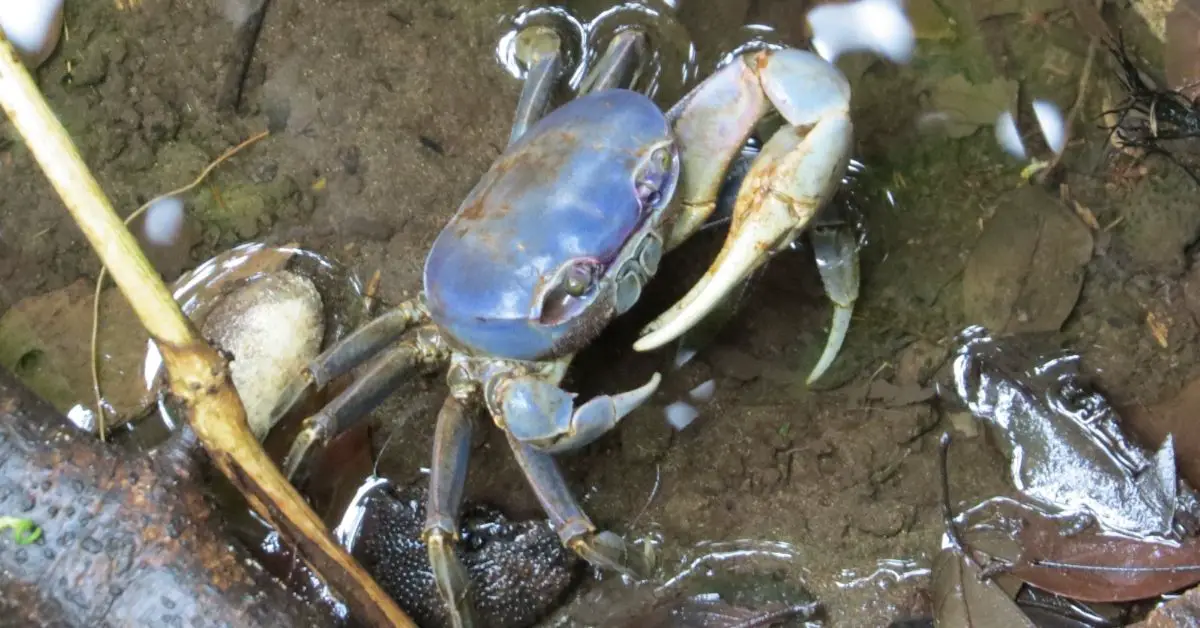Can blue crabs live in a freshwater pond? Blue crabs are amazing animals that can thrive in saltwater and freshwater. So, if you have a pond in your backyard, then they may be able to make it work. They need at least three feet of depth (shallow ponds will not work) and the temperature should stay between 65-75 degrees Fahrenheit.
In general, blue crabs do not like extremely cold weather or extremely warm weather. If they have a pond to live in and enough food, then they can survive anywhere with water.
They will need a place to bury themselves for molting and hibernating, so a soft mud bottom with some roots is ideal. If the pond freezes during the winter, then the blue crabs will die, unless it is a very deep pond and they can bury themselves into the mud that is below the ice.
What do blue crabs eat?
Blue crabs eat a variety of foods, including snails and dead fish or other dead animals that have fallen into the water.
They also munch on aquatic plants. Shrimp is another popular blue crab food source.
Cutter Backyard Bug Control Spray Concentrate (2 Pack), Kills Mosquitoes, Fleas & Listed Ants, 32 fl Ounce
27% Off4 Pack 10Ft String Light Poles for Outside, Thickened Metal Lights Hanger Pole Outdoor with Fork, Lighting Hanging Post Accessories for Patio Decor Garden Backyard Yard Front Porch Outside Decorations
32% OffSolar Fence Lights Outdoor - 2700/4000/6000K 3 Mode, IP65 Waterproof Fence Solar Lights Outdoor, Fence Light Solar Powered for Outside, Backyard/Railing/Step/Patio/Wall and home improvement(8 pack)
$43.88 ($5.48 / Count) (as of June 28, 2025 08:16 GMT +03:00 - More infoProduct prices and availability are accurate as of the date/time indicated and are subject to change. Any price and availability information displayed on [relevant Amazon Site(s), as applicable] at the time of purchase will apply to the purchase of this product.)What problems do blue crabs cause?
Blue crabs are usually not troubling to people because they stay underwater most of the time. Occasionally, however, they will come onto land and climb trees looking for food. In this situation, they can be a nuisance and should be removed.
Additionally, blue crabs will sometimes eat small fish or baby ducks that are swimming around in the water.
Is it possible to grow blue crabs in a pond?
It is possible to raise blue crabs in a pond, as long as you can manage the temperature of the water.
Blue crabs prefer to live in brackish water, which is a mixture of fresh and saltwater. If you can manage the temperature of the water so it is not too low or too high for blue crabs, then they should be able to survive in your pond.
The optimal temperature range for blue crabs is 65-75 degrees Fahrenheit. If the water becomes too warm, then the blue crabs will only survive for about one month. If the water becomes too cold, then they will not be able to maintain their metabolism and they will die after just one week.
Blue crabs are also very sensitive to pollutants in the water. If you use an aerobic septic system rather than a traditional septic tank then the system will not be able to break down and remove many of these pollutants. If you can keep environmental pollutants out of your pond, then blue crabs should be able to survive there just fine.
How long can blue crabs live in freshwater?
Blue crabs can live in fresh water for a while, but usually, they will die within a few months because the lack of saltwater and brackish water makes it difficult for them to maintain their metabolism.
In order to survive in freshwater, blue crabs need to have access to saltwater or brackish water every month or so. If they can get to the saltwater or brackish water at least once every month, then they should be able to survive in freshwater.
What should you do if you find blue crabs in your freshwater pond?
If you live near the coast and have a backyard trout pond that is connected to the ocean, then it is likely that some blue crabs will wander into your pond.
And if you need to remove them from your pond?
The easiest way to do this is by using a net and scooping the crabs out of the water. Blue crabs can also be picked up by hand, though you should wear gloves so they don’t pinch you.
If you live in an area where blue crabs are not common, then you should not worry about them. However, if blue crabs start invading your freshwater pond, then you should cover it or fence it so they cannot get in.
You can also attach a pipe to the drain at the bottom of your pond so fresh water will flow in regularly and remove any saltwater that enters with the blue crabs.
Article Summary
Blue crabs can live in a freshwater pond as long as the temperature is right and there are no pollutants. If you have those conditions, then it is possible to grow blue crabs in your pond.
However, they will need access to saltwater or brackish water every month or so for survival because freshwater does not provide all of the necessary nutrients that they need.
In order to remove them from your pond when needed, use a net with scooping capabilities and wear gloves while handling them by hand since their pincers cause irritation if touched directly on the skin.




















